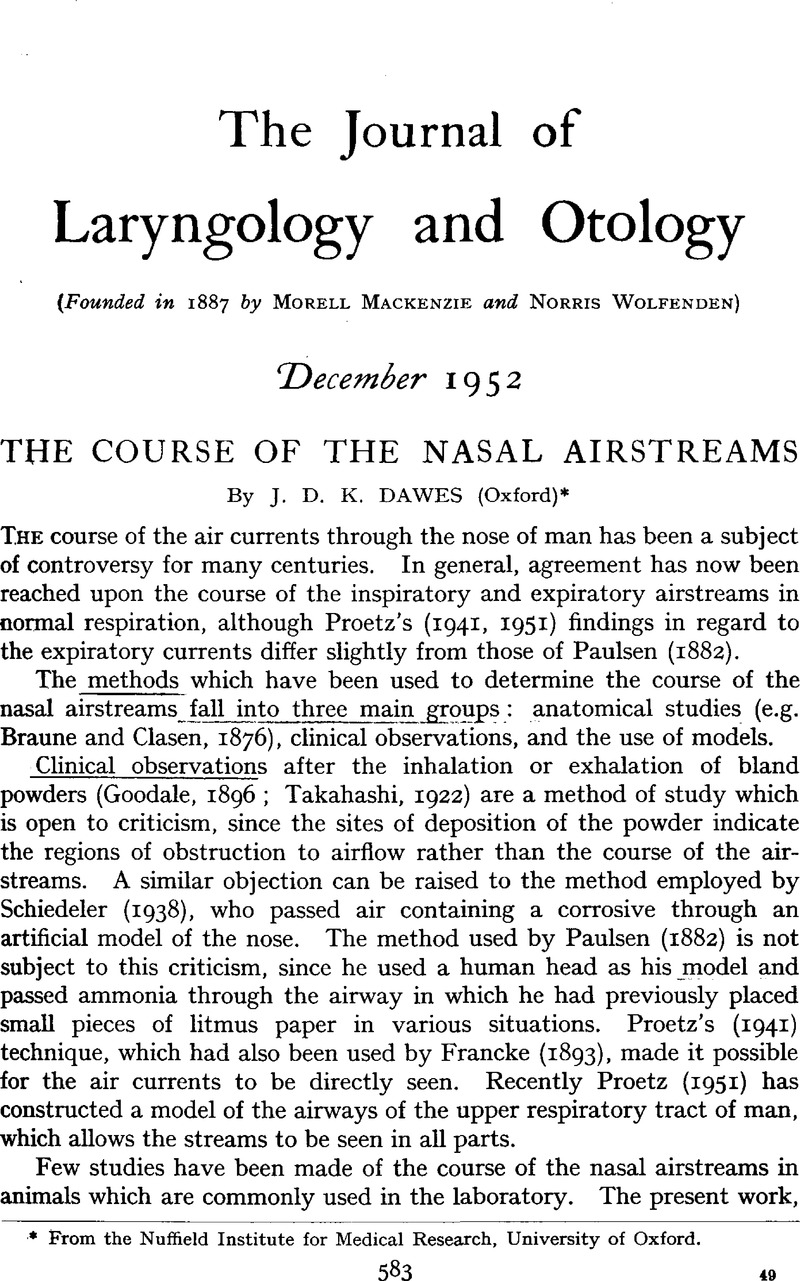Crossref Citations
This article has been cited by the following publications. This list is generated based on data provided by Crossref.
CHEW, ROBERT M.
1965.
Physiological Mammalogy.
p.
43.
Proctor, D F
1966.
Airborne disease and the upper respiratory tract.
Bacteriological Reviews,
Vol. 30,
Issue. 3,
p.
498.
Vaughan, Thomas R.
Jennelle, Lesta F.
and
Lewis, Trent R.
1969.
Long-Term Exposure to Low Levels of Air Pollutants.
Archives of Environmental Health: An International Journal,
Vol. 19,
Issue. 1,
p.
45.
Adams, Donald R.
and
McFarland, L. Z.
1972.
Morphology of the nasal fossae and associated structures of the hamster (Mesocricetus auratus).
Journal of Morphology,
Vol. 137,
Issue. 2,
p.
161.
Adams, Donald R.
and
Hotchkiss, Donald K.
1983.
The Canine Nasal Mucosa.
Anatomia, Histologia, Embryologia,
Vol. 12,
Issue. 2,
p.
109.
Youngentob, Steven L.
Mozell, Maxwell M.
Sheehe, Paul R.
and
Hornung, David E.
1987.
A quantitative analysis of sniffing strategies in rats performing odor detection tasks.
Physiology & Behavior,
Vol. 41,
Issue. 1,
p.
59.
Morris, John B.
1990.
First-pass metabolism of inspired ethyl acetate in the upper respiratory tracts of the F344 rat and Syrian hamster.
Toxicology and Applied Pharmacology,
Vol. 102,
Issue. 2,
p.
331.
Adams, Donald R.
Jones, Alisa M.
Plopper, Charles G.
Serabjit‐Singh, Cosette J.
and
Philpot, Richard M.
1991.
Distribution of cytochrome P‐450 monoxygenase enzymes in the nasal mucosa of hamster and rat.
American Journal of Anatomy,
Vol. 190,
Issue. 3,
p.
291.
Renne, Roger A.
Brown, H. Roger
and
Jokinen, Micheal P.
1992.
Morphology of Nasal Lesions Induced in Osborne-Mendel Rats and B6C3F1 Mice by Chronic Inhalation of Allyl Glycidyl Ether.
Toxicologic Pathology,
Vol. 20,
Issue. 3-1,
p.
416.
Hillenius, Willem J.
1994.
TURBINATES IN THERAPSIDS: EVIDENCE FOR LATE PERMIAN ORIGINS OF MAMMALIAN ENDOTHERMY.
Evolution,
Vol. 48,
Issue. 2,
p.
207.
Giannetti, N.
Saucier, D.
and
Astic, L.
1995.
Analysis of the possible alerting function of the septal organ in rats: A lesional and behavioral study.
Physiology & Behavior,
Vol. 58,
Issue. 5,
p.
837.
Witmer, Lawrence M.
2001.
Nostril Position in Dinosaurs and Other Vertebrates and Its Significance for Nasal Function.
Science,
Vol. 293,
Issue. 5531,
p.
850.
Clifford, Andrew B.
and
Witmer, Lawrence M.
2004.
Case studies in novel narial anatomy: 2. The enigmatic nose of moose (Artiodactyla: Cervidae: Alces alces).
Journal of Zoology,
Vol. 262,
Issue. 4,
p.
339.
Settles, Gary S.
2005.
Sniffers: Fluid-Dynamic Sampling for Olfactory Trace Detection in Nature and Homeland Security—.
Journal of Fluids Engineering,
Vol. 127,
Issue. 2,
p.
189.
Morris, John
2005.
Inhalation Toxicology, Second Edition.
p.
349.
Wiestner, Thomas S.
Koch, Daniel A.
Nad, Natascha
Balli, Aaron
Roos, Malgorzata
Weilenmann, Richard
Michel, Erika
and
Arnold, Susanna
2007.
Evaluation of the repeatability of rhinomanometry and its use in assessing transnasal resistance and pressure in dogs.
American Journal of Veterinary Research,
Vol. 68,
Issue. 2,
p.
178.
Craven, Brent A.
Paterson, Eric G.
Settles, Gary S.
and
Lawson, Michael J.
2009.
Development and Verification of a High-Fidelity Computational Fluid Dynamics Model of Canine Nasal Airflow.
Journal of Biomechanical Engineering,
Vol. 131,
Issue. 9,
Witmer, Lawrence M.
and
Ridgely, Ryan C.
2009.
New Insights Into the Brain, Braincase, and Ear Region of Tyrannosaurs (Dinosauria, Theropoda), with Implications for Sensory Organization and Behavior.
The Anatomical Record,
Vol. 292,
Issue. 9,
p.
1266.
Ensminger, John J.
2010.
Canine Tracking and Scent Identification: Factoring Science into the Threshold for Admissibility.
SSRN Electronic Journal,
Schuenemann, Riccarda
and
Oechtering, Gerhard
2014.
Inside the Brachycephalic Nose: Conchal Regrowth and Mucosal Contact Points After Laser-Assisted Turbinectomy.
Journal of the American Animal Hospital Association,
Vol. 50,
Issue. 4,
p.
237.



